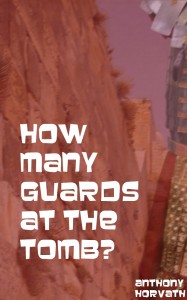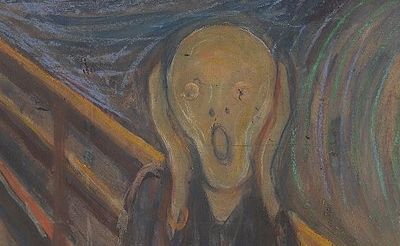 (this is the continuation of a series of essays discussing the number and make-up of the guards at Jesus’ tomb. It can be purchased as an ebook, cover to the right. Main essay | Previous section | Next section: Pilate Puts Jesus on Trial, the Jews put Pilate on Trial )
(this is the continuation of a series of essays discussing the number and make-up of the guards at Jesus’ tomb. It can be purchased as an ebook, cover to the right. Main essay | Previous section | Next section: Pilate Puts Jesus on Trial, the Jews put Pilate on Trial )
The Romans and Jews: So (un)Happy Together
The region of Palestine had been conquered by one empire after another before the Romans finally took hold of it around 70 BC. Indeed, going back even as far as the book of Exodus, we find that one of the roads through the region was called “The Way of the Kings,” presumably because this was the road that the kings marched their armies to war on their way to conquer something more important. The Romans no doubt regretted taking possession of the area, as the occupants were irascible folks, constantly nipping at their heels, all of whom had the unfortunate belief that their own king’s arrival was imminent.
Unfortunately for the Romans, and the Greeks, and the Persians, and the Egyptians, and the [fill in the blank], Palestine had to be dealt with if one wished to conquer the world. If you look at a map, you will understand why. To the east of the region is a vast wilderness and desert. If Greece wanted to attack Egypt, they had to go through Palestine. If Egypt wanted to attack Persia, they had to go through Palestine. So on and so forth. You get the picture; it was the Way of the Kings for a reason: it was the only way for the kings.. Studying a map of the area would be a good idea at this point.
Detailing the troubled relations between the Romans and the Jews would take a book to accomplish, but focusing on Pontius Pilate’s rule over the Jews is a suitable snapshot, especially as it has bearing on Jesus’ death and resurrection, since Pilate, of course, was the man on the scene.
Pilate was the governor of Judea from 26 AD to 36 AD. In this ten years, he made few friends in the region.
The Jewish writer Philo in his “Embassy to Gaius” tells of many injustices done to the Jews by the Romans, but relates several specific stories about Pilate’s actions.
The first story involves Pilate having some shields with (innocent) inscriptions placed in Herod’s palace, in Jerusalem. This outraged the Jews, who were steadfastly opposed to such things. Pilate is described as a man of a very inflexible disposition, and very merciless as well as very obstinate.”
The Jews at last threaten to send a letter to Tiberius, and Pilate, fearing they might actually follow through on their threat, and so expose Pilate “with respect to other particulars of his government, in respect to his corruption, and his acts of insolence, and his rapine, and his habit of insulting people, and his cruelty, and his continual murders of people untried and uncondemned, and his never ending, and gratuitous, and most grievous inhumanity.”
This gives you a flavor of how Philo the Jew perceived Pilate. In the end, Pilate sent the letter himself rather than let the Jews send it; The Emperor’s response is reported to be less than happy with Pilate; Pilate removes the shields.
Josephus, the Jewish historian, tells of some other conflicts between Pilate and the Jews.
In one of them, Pilate again brings images into Jerusalem. The people are outraged and appeal to him. When Pilate refuses to have them removed, “they fell down prostrate upon the ground, and continued immovable in that posture for five days and as many nights.” What happens next is best told in full:
On the next day Pilate sat upon his tribunal, in the open market-place, and called to him the multitude, as desirous to give them an answer; and then gave a signal to the soldiers, that they should all by agreement at once encompass the Jews with their weapons; so the band of soldiers stood round about the Jews in three ranks. The Jews were under the utmost consternation at that unexpected sight. Pilate also said to them that they should be cut in pieces, unless they would admit of Caesar’s images, and gave intimation to the soldiers to draw their naked swords. Hereupon the Jews, as it were at one signal, fell down in vast numbers together, and exposed their necks bare, and cried out that they were sooner ready to be slain, than that their law should be transgressed. Hereupon Pilate was greatly surprised at their prodigious superstition, and gave order that the ensigns should be presently carried out of Jerusalem.
At this point, one might feel like they could describe the relationship between Pilate and the Jews as an immovable wall meeting an unstoppable force, except for the fact that Pilate does, in the end, relent.
Josephus proceeds immediately then to tell the story of Pilate raiding the temple treasury to pay for aqueducts. This time when the Jews showed up to protest,
“he mixed his own soldiers in their armor with the multitude, and ordered them to conceal themselves under the habits of private men, and not indeed to use their swords, but with their staves to beat those that made the clamor. He then gave the signal from his tribunal [to do as he had bidden them]. Now the Jews were so sadly beaten, that many of them perished by the stripes they received, and many of them perished as trodden to death by themselves; by which means the multitude was astonished at the calamity of those that were slain, and held their peace.”
So, that time, the immovable wall held fast. Eventually, Pilate’s violent and aggressive tactics would lead to his dismissal. Josephus recounts that Pilate slaughtered some Samaritans (a group of people living in Palestine), who then complained to the governor of Syria, who in turn sent Pilate to Rome. Little is known about Pilate’s fate after this, but it is against this brutal pattern of behavior and disregard and contempt for the Jews that we must now consider the story of Jesus’ trial and the guarding of the tomb.



Recent Comments